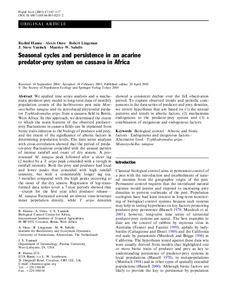| dc.contributor.author | Hanna, R. |
| dc.contributor.author | Onzo, A. |
| dc.contributor.author | Lingeman, R. |
| dc.contributor.author | Yaninek, J.S. |
| dc.contributor.author | Sabelis, M.W. |
| dc.date.accessioned | 2019-12-04T11:22:15Z |
| dc.date.available | 2019-12-04T11:22:15Z |
| dc.date.issued | 2005-08 |
| dc.identifier.citation | Hanna, R., Onzo, A., Lingeman, R., Yaninek, J.S. & Sabelis, M.W. (2005). Seasonal cycles and persistence in an acarine predator-prey system on cassava in Africa. Population Ecology, 47(2), 107-117. |
| dc.identifier.issn | 1438-3896 |
| dc.identifier.uri | https://hdl.handle.net/20.500.12478/3975 |
| dc.description.abstract | We applied time series analysis and a mechanistic predator-prey model to long-term data of monthly population counts of the herbivorous pest mite Mononychellus tanajoa and its introduced phytoseiid predator Typhlodromalus aripo from a cassava field in Benin, West Africa. In this approach, we determined the extent to which the main features of the observed predator-prey fluctuations in cassava fields can be explained from biotic traits inherent to the biology of predator and prey, and the extent of the significance of abiotic factors in determining population levels. The time series analyses with cross-correlation showed that the period of predator-prey fluctuations coincided with the annual pattern of intense rainfall and onset of dry season. A pronounced M. tanajoa peak followed after a short lag (2 weeks) by a T. aripo peak coincided with a trough in rainfall intensity. Both the prey and predator had local and lower peaks that coincided with high rainfall intensity, but with a considerably longer lag (ca. 3 months) compared with the high peaks occurring at the onset of the dry season. Regression of log-transformed data series (over a 7-year period) showed that—except for the first year after predator release—M. tanajoa fluctuated around an almost time-invariant mean population density, while T. aripo densities showed a consistent decline over the full observation period. To explain observed trends and periodic components in the data-series of predator and prey densities, we review hypotheses that are based on (1) the annual patterns and trends in abiotic factors, (2) mechanisms endogenous to the predator-prey system and (3) a combination of exogenous and endogenous factors. |
| dc.description.sponsorship | United Nations Development Programme |
| dc.description.sponsorship | Danish International Development Agency |
| dc.description.sponsorship | International Fund for Agricultural Development |
| dc.description.sponsorship | Netherlands Organisation for Scientific Research |
| dc.language.iso | en |
| dc.subject | Biological Control |
| dc.subject | Cassava |
| dc.subject | Predators |
| dc.subject | Dry Season |
| dc.subject | Biotic Traits |
| dc.subject | Cowpeas |
| dc.title | Seasonal cycles and persistence in an acarine predator-prey system on cassava in Africa |
| dc.type | Journal Article |
| dc.description.version | Peer Review |
| cg.contributor.crp | Roots, Tubers and Bananas |
| cg.contributor.affiliation | International Institute of Tropical Agriculture |
| cg.contributor.affiliation | University of Amsterdam |
| cg.contributor.affiliation | Purdue University |
| cg.coverage.region | Africa |
| cg.coverage.region | West Africa |
| cg.coverage.country | Benin |
| cg.isijournal | ISI Journal |
| cg.authorship.types | CGIAR and advanced research institute |
| cg.iitasubject | Cassava |
| cg.iitasubject | Pests Of Plants |
| cg.accessibilitystatus | Limited Access |
| local.dspaceid | 99261 |
| cg.identifier.doi | https://doi.org/10.1007/s10144-005-0215-2 |

